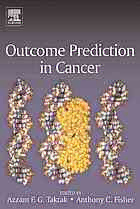
Outcome prediction in cancer PDF
Preview Outcome prediction in cancer
OUTCOME PREDICTION IN CANCER This page intentionally left blank OUTCOME PREDICTION IN CANCER Editors AZZAM F.G. TAKTAK and ANTHONYC. FISHER Department ofClinical Engineering Royal Liverpool University Hospital United Kingdom Amsterdam • Boston • Heidelberg • London • New York • Oxford Paris • San Diego • San Francisco • Singapore • Sydney • Tokyo ELSEVIER Radarweg 29, PO Box 211, 1000 AE Amsterdam, The Netherlands The Boulevard, Langford Lane, Kidlington, Oxford OX5 1GB, UK First edition 2007 Copyright ©2007 Elsevier B.V. All rights reserved No part of this publication may be reproduced, stored in a retrieval system or transmitted in any form or by any means electronic, mechanical, photocopying, recording or otherwise without the prior written permission of the publisher Permissions may be sought directly from Elsevier’s Science & Technology Rights Department in Oxford, UK: phone (+44) (0) 1865 843830; fax (+44) (0) 1865 853333; Email: [email protected]. Alternatively you can submit your request online by visiting the Elsevier web site at http://elsevier.com/locate/permissions, and selecting: Obtaining permission to use Elsevier material Notice No responsibility is assumed by the publisher for any injury and/or damage to persons or property as a matter of products liability, negligence or otherwise, or from any use or operation of any methods, products, instructions or ideas contained in the material herein. Because of rapid advances in the medical sciences, in particular, independent verification of diagnoses and drug dosages should be made ISBN-13: 978-0-444-52855-1 ISBN-10: 0-444-52855-5 For information on all Elsevier publications visit our website at books.elsevier.com Printed and bound in The Netherlands 07 08 09 10 11 10 9 8 7 6 5 4 3 2 1 To my wife Diane for all the help and support in preparing this book A. Taktak This page intentionally left blank Foreword We live in an era of contrasts, when rapidly developing science and technology from genetic research to availability of astounding computing power, still fall short of addressing societal expectations of individualized patient care. This is especially relevant in the clinical management of cancer, where prediction of the likely outcome from standard or alternative treatments is criticial. This book reviews recent advances across a range of disciplines, including integrated decision support systems comprising molecular markers, from histopathology to clinical signs, which combine with sophisticated non-linear mathematical and statistical methods to accurately predict outcome from standard treatment. These developments make way for personalized inferences using as much as possible of the individual’s bioprofile, in order to explore the covariate dependence of outcomes of interest—typically, diagnosis of malig- nancy, tumour grading, or time-to-event statistics for mortality and recurrence. Current improvements in generic non-linear algorithms enable explicit modelling of complex decision boundaries and survival curves, without resorting to limiting assump- tions regarding parameter linearity or hazard proportionality. Nevertheless, it is advisable to adopt a realistic approach to complex non-linear modelling, with a clear understanding of the biological significance of the candidate biomarkers for predictive inference, since the availability of vast numbers of genetic indicators, for example, runs the risk of identi- fying spurious correlations that would not stand up in the analysis of unseen data. Recommendations for robust non-linear processing, illustrated by real-world case studies, have been made in several chapters of this book. Several analyses of censored time-to- event data, so crucial to modelling cancer outcomes, are benchmarked against proven statistical methods. This demonstrates the robustness, flexibility and predictive accuracy achieved by powerful new analytical frameworks. Difficult issues essential for obtaining reliable predictions are addressed, including model selection and efficient regularization. Practical decision support systems also require an infrastructure supporting standardized data acquisition from remote centres and for remote access. These issues are equally as critical as the use of advanced analysis methods, since reliance on data-based models depends on the completeness, integrity and consistency of the underlying data. An important message of the book is that the added value from data analysis now justifies an investment on standardized protocols for data acquisition and monitoring. This enables multicentre modelling and evaluation studies to take place on a large scale, beyond what is possible solely on the basis of existing historical patient records. vii viii Foreword In conclusion, this book is an up-to-date review of the state-of-the-art in several key elements for practical outcome prediction, which is of special importance for the manage- ment of cancer. It makes the case for collaborative efforts between technical and scientific disciplines, such as cytogenetics, healthcare informatics and machine learning, and, beyond them, into the clinical arena. Strictly standardized practices in data acquisition, laboratory measurements, clinical protocols and data recording will magnify the value already abstracted through the use of sophisticated numerical methods. They will bridge the gap between “dead data”, repre- senting clinical audit trails, and prospective data, from which solid insights are gained into the phenomenology of cancer. They also serve as practical clinical instruments for predic- tive inference evidence on the basis of previous patient histories. My hope is that this book will, in some way, inspire the beginning of this momentous transformation. Paulo J.G. Lisboa, BSc, PhD, CEng, FIEE, FIMA School of Computing and Mathematical Sciences Liverpool John Moores University United Kingdom Contents Foreword vii Contributors xiii Introduction xvii Section 1 – The Clinical Problem 1 Chapter 1 The Predictive Value of Detailed Histological Staging of Surgical Resection Specimens in Oral Cancer 3 J.A. Woolgar Chapter 2 Survival after Treatment of Intraocular Melanoma 27 B.E. Damato and A.F.G. Taktak Chapter 3 Recent Developments in Relative Survival Analysis 43 T.R. Hakulinen and T.A. Dyba Section 2 – Biological and Genetic Factors 65 Chapter 4 Environmental and Genetic Risk Factors of Lung Cancer 67 A. Cassidy and J.K. Field Chapter 5 Chaos, Cancer, the Cellular Operating System and the Prediction of Survival in Head and Neck Cancer 101 A.S. Jones ix
